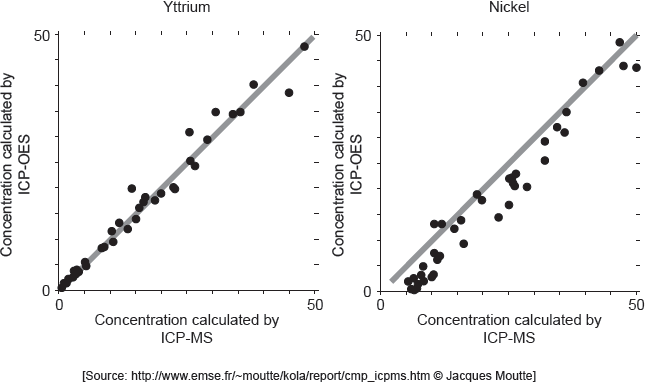| Date | November 2018 | Marks available | 1 | Reference code | 18N.3.hl.TZ0.3 |
| Level | HL | Paper | 3 | Time zone | TZ0 |
| Command term | State | Question number | 3 | Adapted from | N/A |
Question
The presence of very small amounts of lead in calcium-based antacids can be determined using inductively coupled plasma-mass spectroscopy (ICP-MS).
An unknown antacid sample has a lead ion concentration of 0.50 μg dm‒3.
Chelating agents can be used to treat heavy metal poisoning.
State the type of particle present in the plasma formed.
Calculate the concentration of lead ions in the sample in mol dm‒3.
Lead ions are toxic and can be precipitated using hydroxide ions.
Pb2+ (aq) + 2OH‒ (aq) Pb(OH)2 (s)
Sufficient sodium hydroxide solid is added to the antacid sample to produce a 1.0 × 10‒2 mol dm‒3 hydroxide ion solution at 298 K.
Deduce if a precipitate will be formed, using section 32 of the data booklet.
If you did not calculate the concentration of lead ions in (b)(i), use the value of 2.4 × 10−4 mol dm‒3, but this is not the correct value.
Electrolysis is used to obtain lead from Pb2+ (aq) solution.
Determine the time, in hours, required to produce 0.0500 mol lead using a current (I) of 1.34 A. Use section 2 of the data booklet and the equation, charge (Q) = current (I) × time (t, in seconds).
State one feature of a chelating agent.
An aqueous lead(II) ion reacts with three ethane-1,2-diamine molecules to form an octahedral chelate ion.
Outline why the chelate ion is more stable than the reactants.
Markscheme
positive ions/cations/Pb2+
OR
free electrons ✔
Accept “ions” OR “charged species/particle”.
[Pb2+] = 0.50 × 10‒6/5.0 × 10–7 «g dm–3» ✔
[Pb2+] «» = 2.4 × 10‒9 «mol dm‒3» ✔
Award [2] for correct final answer.
«Ksp = 1.43 × 10–20»
ALTERNATIVE 1:
«Q = [Pb2+] [OH–]2 = 2.4 × 10–9 × (1.0 × 10–2)2» = 2.4 × 10–13 ✔
Q > Ksp AND precipitate will form
OR
2.4 × 10–13 > 1.43 × 10–20 AND precipitate will form ✔
ALTERNATIVE 2:
critical [Pb2+] for hydroxide solution «» = 1.4 × 10–16 ✔
initial concentration > critical concentration AND precipitate will form
OR
2.4 × 10–9 > 1.4 × 10–16 AND precipitate will form ✔
If value given is used:
ALTERNATIVE 3:
«Q = [Pb2+] [OH–]2 = 2.4 × 10–4 × (1.0 × 10–2)2» = 2.4 × 10–8 ✔
Q > Ksp AND precipitate will form
OR
2.4 × 10–8 > 1.43 × 10–20 AND precipitate will form ✔
«Faraday’s constant, F = 9.65 × 104 C mol‒1 and 1 A = 1 C s–1»
Q «= 0.0500 mol × 2 × 96500 C mol‒1» = 9650 «C» ✔
t « so » = 2.00 «hours» ✔
Award [2] for correct final answer.
Any one of:
two «or more» lone/non-bonding pairs on different atoms
OR
two «or more» atoms/centres that act as Lewis bases ✔
form «at least» two coordination/coordinate bonds
OR
«at least» two atoms can form coordination/coordinate bonds ✔
Reference to “on DIFFERENT atoms” required.
Accept “dative «covalent» bond” for “coordination/coordinate bond”.
increase in entropy
OR
ΔS > 0/ΔS positive ✔
Accept “ΔG < 0” but not “ΔH < 0”.


